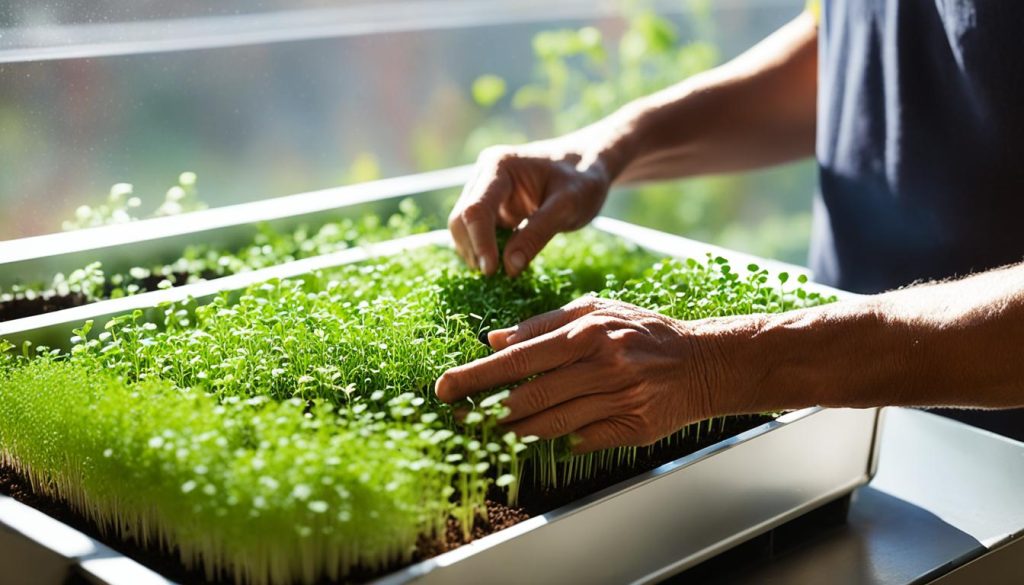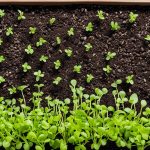Are you eyeing those delicate sprouts in your garden, wondering when to harvest microgreens? It’s a pivotal question that can make a grand difference in the taste and nutritional punch of these tiny greens. Generally, the best time to harvest microgreens is a sprint, not a marathon, typically ranging from 8 to 21 days post-sowing, but timing can be as precise as a chef’s knife. Spotting the perfect window for harvest calls for a keen eye for detail and a bit of green-thumb intuition.
Heeding the right microgreen harvesting tips can elevate your culinary game by ensuring each harvest is bursting with flavor and vitality. We’re here to guide you through the signs of maturity and optimal conditions, empowering you to reel in your greens at their peak. Are you ready to unlock the secret to a plentiful microgreen bounty? Let’s dig in.
Understanding Microgreen Maturity for Harvesting
Growing microgreens is an art and a science, with the final product’s flavor and nutrition largely dependent on harvesting microgreens at the right stage. Whether you’re a seasoned grower or a novice green thumb, recognizing the maturity of your microgreens is critical for reaping the best harvest.
Identifying Germination and Cotyledon Stages
The initial stages of microgreen growth set the foundation for a successful yield. After sowing, the germination phase begins, where seeds awaken and sprout to reveal their first signs of life. This quickly transitions into the cotyledon stage, marked by the appearance of the first leaves. It’s important to note these leaves, although vibrant and promising, do not fully represent the plant’s true potent potential.
Assessing True Leaf Development for Peak Harvest
The true leaf stage speaks volumes about microgreen maturity. This pivotal point occurs when the secondary set of leaves emerges, showcasing the distinct characteristics of their mature counterparts. True leaves are the telltale signs of when to harvest microgreens, and snipping them at this juncture ensures you unlock the full spectrum of flavors and nutrient density these tiny greens have to offer.
When to Harvest Microgreens: Tracking Growth
Embarking on the journey of microgreen cultivation leads to the pivotal question of proper timing for microgreen harvesting. The transformation from seed to plate is a brief and delicate process, where every day counts. To maximize the unique flavors and rich nutrients that microgreens offer, understanding and determining the ideal harvest time for microgreens is vital to any green thumb. Let’s delve into the factors that signal it’s time to gather these tiny yet mighty greens.
Optimal Harvesting Timeline from Seeding to Plate
The art of microgreen cultivation revolves around precision. These verdant treasures reach peak maturity swiftly, generally measuring 1-3 inches tall at harvest. Gardeners and chefs alike yearn for this moment, where the lush tapestry of greens bursts with vitality. The timeline is variety-dependent, but it can be delineated generally. Nutrient-packed pea shoots garnish dishes best between 10-14 days post-sowing, while spicy radish microgreens enliven palates at 7-10 days. For a nuttier essence, sunflower microgreens suggest a similar readiness around 10-14 days. Each variety weaves its own unique timeline into the quilt of microgreen harvesting knowledge.
Importance of Light and Water for Timely Harvests
Integral to the fiber of successful growth and hence, timely harvesting, are the twin beacons of light and water. Sunlight, the golden thread of life, should grace the microgreens with approximately four hours of its presence daily. Meanwhile, a judicious regimen of water—an elixir in its own right—ensures that each microgreen unfurls its potential. These two elements, in harmonious balance, orchestrate the symphony of growth that crescendos into the perfect harvest moment. By heeding the rhythm of light and water, the pinnacle of harvesting calls—and one must simply answer.
Signs of When to Harvest Microgreens
Aspiring gardeners and chefs alike seek to achieve that bountiful harvest of microgreens, but it’s essential to recognize when to cut microgreens for the best yield in flavor and nutrition. The peak time for snipping those tender shoots lies within considering visual markers and an understanding of microgreen maturity. Let’s delve into the indicators that signal your greens are ready to grace the plate.
Fully opened true leaves are your “green light” to begin harvesting. Unlike their earlier cotyledon counterparts, these leaves showcase the characteristic shape and texture of the plant. Achieving the right height—a couple of inches of lush growth—alongside a sense of fullness, where the greens stand close but not overcrowded, indicates a prime harvest. The vibrant color spectrum of your greens is not just a feast for the eyes but a signal —the richer the hue, the riper the crop.
However, timing is as crucial as observation. A keen eye must watch for early signs of distress among the plants, such as yellowing or a halt in growth. These cues suggest the onset of aging or adverse growing conditions. The lesson here is to harvest promptly, for microgreens at their prime possess the most tantalizing taste and are packed with nutritional prowess.
By harnessing these insights, you can ensure that each cut of your microgreens delivers the utmost in culinary delight, a testament to the delicate interplay between gardener’s intuition and a plant’s natural cycle. Happy harvesting!
Harvesting Microgreens for Optimal Flavor
Unlocking the full taste potential of microgreens lies in the precise timing of their harvest. For connoisseurs and cultivators alike, the allure of microgreens is not only in their nutritional density but also in their complex flavor profiles. The varying stages of growth, from the nascent cotyledon to the burgeoning true leaf, each offer a distinct sensory experience. Thus, understanding and executing the proper harvesting window is paramount for harvesting microgreens for optimal flavor and ensuring unsurpassed microgreen palatability.

Taste Testing Different Harvest Stages
The art of flavor lies in the nuanced differences between each stage of the microgreen lifecycle. As these diminutive greens pass from the cotyledon phase into the full glory of true leaves, their flavors intensify and mature. Gourmet chefs and home cooks alike revel in conducting taste tests at various intervals post-germination to identify those moments when flavor, texture, and aroma converge to perfection.
Influencing Factors on Microgreen Palatability
Not to be overlooked are the myriad factors that influence the ultimate taste and texture of microgreens. Variety-specific characteristics can dictate the inherent sweetness, spiciness, or earthiness present in each leaf. Moreover, the environmental canvas upon which these plants grow – soil quality, hydration, and light exposure – plays a vital role in nurturing the greens to their peak deliciousness. When these elements align under the watchful eye of the grower, the result is an elegantly flavorful microgreen, ready for the plate and palate.
Maximizing Nutrient Retention in Microgreen Harvest
The essential window for harvesting microgreens to ensure microgreen nutrient retention is a topic underscored by significant research, including findings from the University of Maryland Extension. To capture the essence of nutrient density, timing the harvest at the true leaf stage is recommended. This is when microgreens display robust levels of vitamins and minerals, contributing to their superfood status.
During the true leaf stage, these tiny greens possess the maximum concentrations of bioavailable nutrients. Making the cut at this juncture is not only about garnering the nutritional riches; it’s also about ensuring the freshest taste experience. Whether used as a garnish, a vibrant addition to salads, or a nutritional boost in smoothies, the true leaf stage is the ideal harvest target.
Adopting sharp, clean tools for harvesting microgreens contributes to maintaining their integrity. This practice prevents excessive crushing or damage, ensuring the greens remain in pristine condition from garden to plate, hence preserving every ounce of their well-earned nutritional profile.
By mindfully harvesting microgreens at this strategic growth phase, you consistently optimize both the flavor profile and nutritional offering. The retention of these vital elements is what sets freshly harvested microgreens apart, elevating them as a powerhouse component in any health-conscious individual’s diet.
Harvesting Microgreens at the Right Stage: Techniques and Tools
Mastering the art of microgreen harvesting techniques involves more than just timing—it’s also about the tools and the touch you use. Whether you’re a home enthusiast or a commercial farmer, proper tools and techniques are vital for preserving the delicate structure and ensuring a high-quality harvest.
Selecting the Correct Tools for Clean Cuts
The essence of a successful harvest lies in the tools you use. The best tools for growing microgreens are those that offer precision and care to avoid bruising or crushing these tender plants. A pair of sharp scissors or a serrated knife are excellent choices; they allow you to snip the stems cleanly without pulling on the roots or disturbing the growing medium. Proper sanitation of these tools cannot be overstressed, as it helps prevent the introduction of diseases and maintains the integrity of your greens.
Best Practices to Avoid Microgreen Damage During Harvest
Handling microgreens with utmost care during the harvest prevents damage and retains their aesthetic appeal. One should harvest in a manner that doesn’t place stress on the roots or remaining shoots, which can lead to premature wilting or decay. Additionally, ensuring your harvest area is clean and free from contaminants will result in microgreens that not only look better but are safer for consumption.
Proper Timing for Microgreen Harvesting: Morning vs Evening
For optimal harvest time, understanding the daily rhythms of plant life is as essential as having the right tools. Remarkably, the ideal moments to gather your microgreens are during the tranquil hours of early morning or the cooling embrace of evening. This strategic timing capitalizes on the plants’ natural cycles, when they’re most hydrated and vibrant after a night’s rest or before the midday sun’s intensity.
It may come as a surprise, but harvesting during these periods does more than just keep the greens at their freshest; it sets the stage for the rest of their journey from garden to plate. Microgreens collected at dawn retain their peak flavors and essential nutrients, making every bite an experience of ultimate taste and health. If morning harvesting is missed, the evening offers a second chance to harvest while still preserving the delicate texture and robust flavors of these nutritious greens.
Whether you prefer to start your day with the morning dew or conclude it with the hush of dusk, following these microgreen harvesting tips will ensure that your microgreens are always crisp, nutrient-dense, and irresistibly flavorful. It’s not just about when you cut; it’s about aligning your harvest with the natural peak of your plants’ potential.
Post-Harvest Handling: Washing, Drying, and Storing
Understanding the proper techniques for cleaning microgreens after harvest is key to enhancing their shelf life and ensuring the best quality. The delicate nature of these greens necessitates gentle handling to maintain their structure and nutritional value.
Cleaning Your Harvest: Techniques and Considerations
Cleanliness is paramount after harvesting microgreens. Begin by gently rinsing them under cool, running water to remove any soil or debris. It’s recommended to use a colander or similar tool to avoid crushing the tender greens. To maintain optimal freshness and hygiene, utilize a salad spinner to gently but effectively dry the microgreens. This helps in preventing excess moisture, which can lead to premature decay.
Maintaining Freshness: From Harvest to Refrigeration
Properly storing microgreens plays a crucial role in preserving their vitality and extending their microgreen shelf life. After cleaning and drying, lay the greens on a clean paper towel and roll them loosely to absorb any additional moisture. Place them in an airtight, food-grade container to maintain humidity levels without allowing condensation. Store the container in the refrigerator to keep the greens fresh; a practice that can significantly enhance the crispness and flavor of the microgreens for up to two weeks.
Determining the Ideal Harvest Time for Microgreens by Variety
Each variety of microgreens blossoms into its prime with unique timing, making variety-specific microgreens harvesting an essential aspect for gardeners and culinary enthusiasts alike. For instance, radish microgreens add a bold, spicy kick to dishes and should be plucked from your garden beds between the 7th and 10th day post-sowing. Precision in timing is key to harnessing their vibrant flavor and vivacious color.
Sunflower microgreens, on the other hand, are known for their crunchy texture and delightful nutty essence. The window of opportunity to harvest these treasures is slightly broader, falling ideally within the 10th to 14th days of growth. Wait any longer, and you might miss out on the mild, yet distinct taste that makes them a favorite in salads and sandwiches.
Lastly, pea shoots – with their tender shoots and leaves – bring a sweetness to the palate that is best captured when they stand 3-4 inches tall, which typically occurs around the 10-14 day mark. Understanding when to harvest microgreens and recognizing the signs that your greens have reached maturity will ensure that each variety meets your plate with the utmost flavor and nutrition intended by nature.


